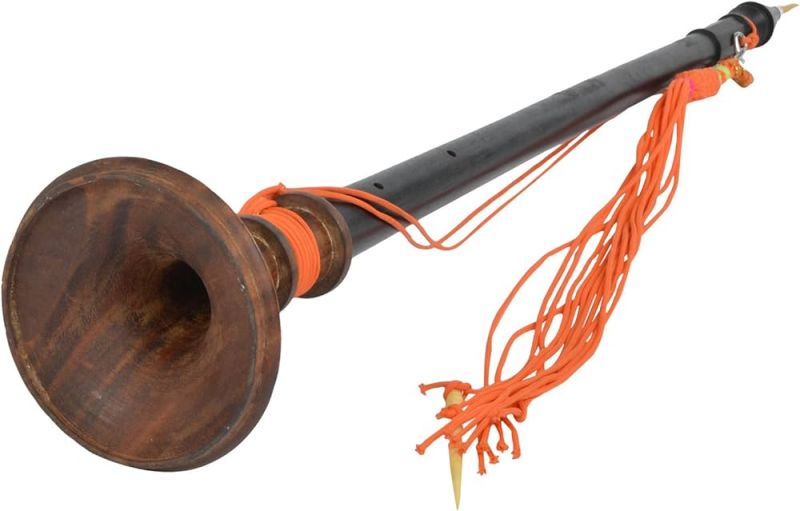Nadaswaram
Woodwinds
Asia
Ancient
Video
The nadaswaram is a prominent double-reed wind instrument widely used in South Indian classical music and folk traditions. Known for its powerful and auspicious sound, it plays a vital role in various cultural and religious ceremonies.
It is also spelled nagaswaram, which is a large, conical double-reed instrument made from wood, typically crafted from dark hardwoods like ebony or other local materials. It features, the instrument can be around 90 to 95 cm (approximately 35 to 37 inches) long and has a flaring bell at one end. It uses a double reed, which is crucial for sound production. The reeds are traditionally made from cane. The nadaswaram has seven finger holes on the front and may have additional holes for tuning adjustments.
Why It Is Used
The nadaswaram is primarily used for: It is considered auspicious and is commonly played at Hindu weddings, temple festivals, and other religious ceremonies. The instrument is integral to South Indian culture, often accompanying traditional dance performances and rituals.
How It Works
Sound production in the nadaswaram involves vibration of the Reed and Pitch Variation. When air is blown into the mouthpiece, the double reed vibrates to create sound. Players can change the pitch by covering or uncovering the finger holes along the body of the instrument. The use of circular breathing allows musicians to produce continuous sound without interruption.
Types
There are several variations of the nadaswaram based on size and regional preferences:
- Standard Nadaswaram: The most common form used in traditional performances.
- Nagaswaram: A variant that may have slight differences in construction or tuning.
- Smaller Versions: Some regions may have smaller versions designed for specific musical contexts or performances.
Origins and Historical Background
The nadaswaram, also known as nathaswaram, is a traditional South Indian wind instrument with a history rooted in ancient Indian culture and temple traditions. Its origins are closely tied to religious, ceremonial, and cultural practices in Tamil Nadu and other parts of South India.
Vedic and Temple Traditions
The nadaswaram is believed to have evolved from instruments described in ancient Indian scriptures, such as the Natya Shastra by Bharata, which discusses musical instruments used in performances and rituals.
It is often associated with temples and religious practices, particularly in Shaivite traditions, and is considered an auspicious instrument.
Cultural and Regional Development
The nadaswaram has its roots in Tamil Nadu but spread to other South Indian states, including Andhra Pradesh, Karnataka, and Kerala. Its usage in weddings, temple rituals, and festivals became widespread over centuries. It is often referred to as the “Mangala Vadya” (auspicious instrument) due to its significant role in religious and celebratory contexts.
Relation to Other Instruments
The nadaswaram is a double-reed instrument similar to the shehnai of North India, but it is longer and produces a more robust and penetrating sound suitable for outdoor performances. It is thought to have been influenced by earlier instruments like the sundari or kuzhal, which were used in ancient Tamil culture.
Significance in South Indian Culture
The nadaswaram is considered sacred and is often played in pairs during Hindu temple rituals, particularly in Tamil Nadu. It is an integral part of Carnatic music, with many traditional compositions written specifically for the instrument. The nadaswaram’s sound is said to mimic the human voice, and its powerful, resonant tone is believed to connect the earthly and divine realms. The history of the nadaswaram dates back centuries. The instrument has ancient origins in South India, with references found in historical texts related to music and culture. Cultural Evolution: Over time, the nadaswaram has evolved alongside South Indian music traditions, becoming an essential part of temple music and festivities.
The nadaswaram is not just a musical instrument; it embodies the cultural heritage of South India. Its powerful sound and significance in religious ceremonies make it an integral part of community identity and tradition. The mastery required to play this instrument reflects its importance in both classical and folk music settings, ensuring its continued relevance in contemporary performances.
FAQ
What Role Does the Nadaswaram Play in Music?
The Nadaswaram plays a crucial role in South Indian classical and folk music, particularly within the Carnatic tradition. It is often featured in temple rituals and celebrations, where its loud and penetrating sound can be heard over large distances. The instrument is traditionally played in pairs, creating a rich harmonic texture alongside the thavil.
What Techniques Are Used to Play the Nadaswaram?
Playing the Nadaswaram requires advanced techniques such as circular breathing, allowing musicians to maintain continuous sound without interruption. Players must master breath control to articulate various pitches and microtones effectively. The fingering technique resembles that of the Indian flute but also involves adjusting lip pressure to modify pitch.
How is the Nadaswaram typically used in Hindu ceremonies?
The Nadaswaram is a vital instrument in Hindu ceremonies, particularly in South India, where it is regarded as an auspicious musical element. It is commonly played during significant events such as weddings, temple festivals, and religious rituals.
 Links
Links
References
Other Instrument
Categories


















